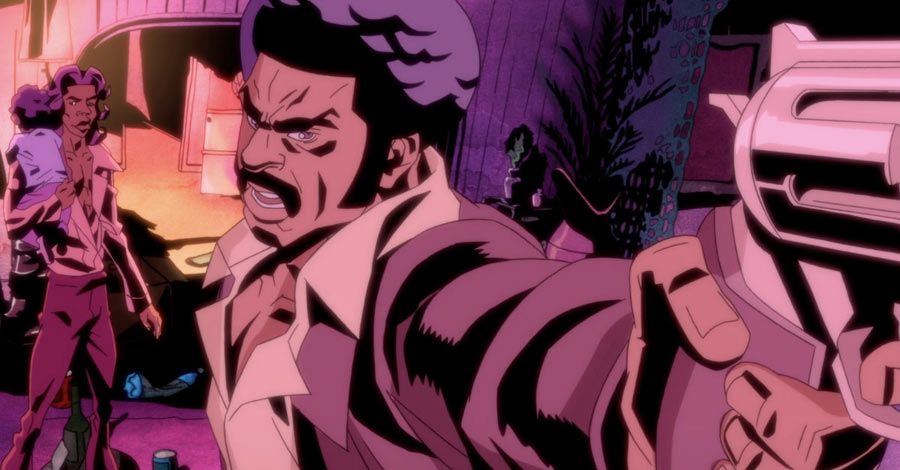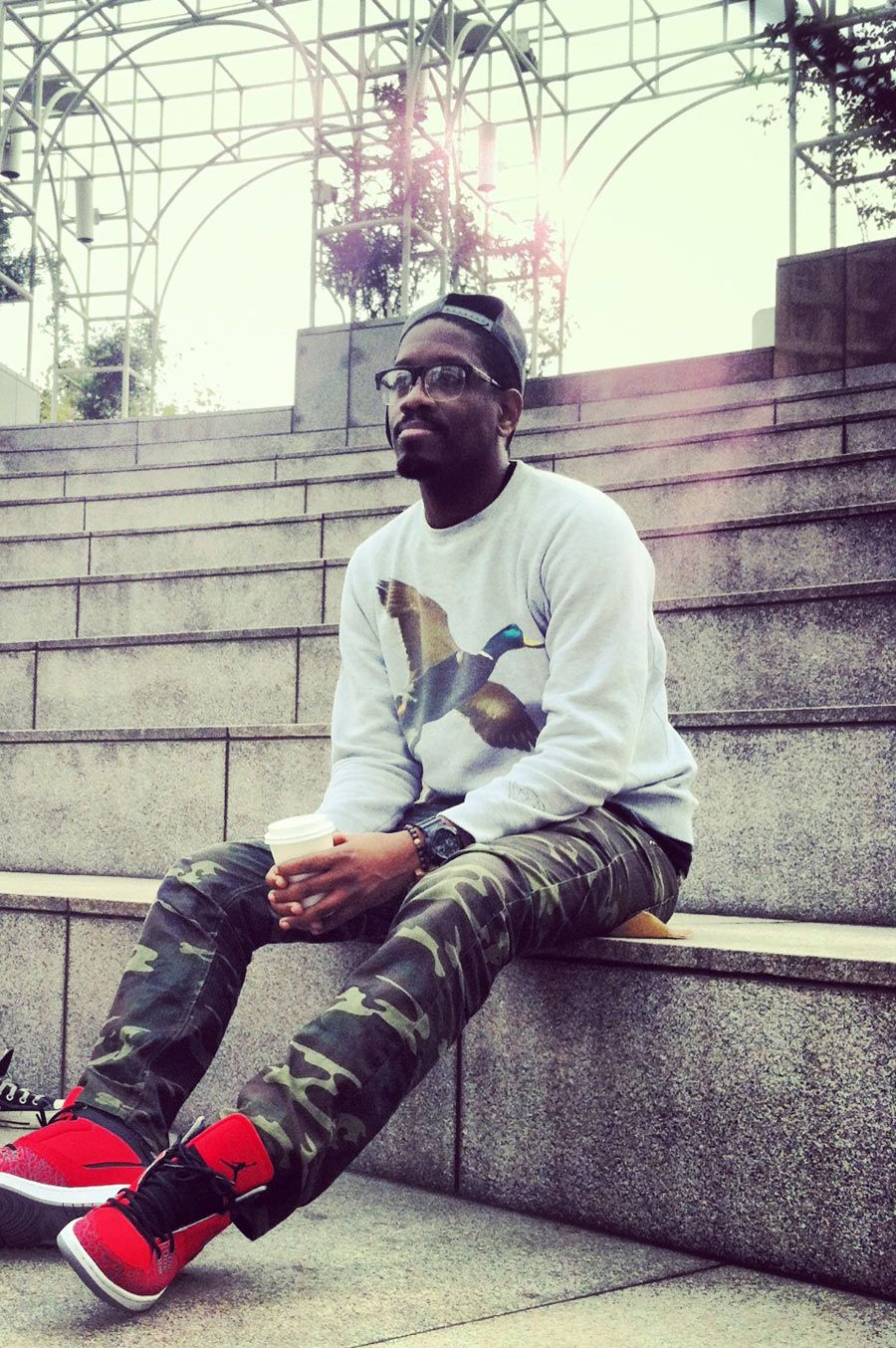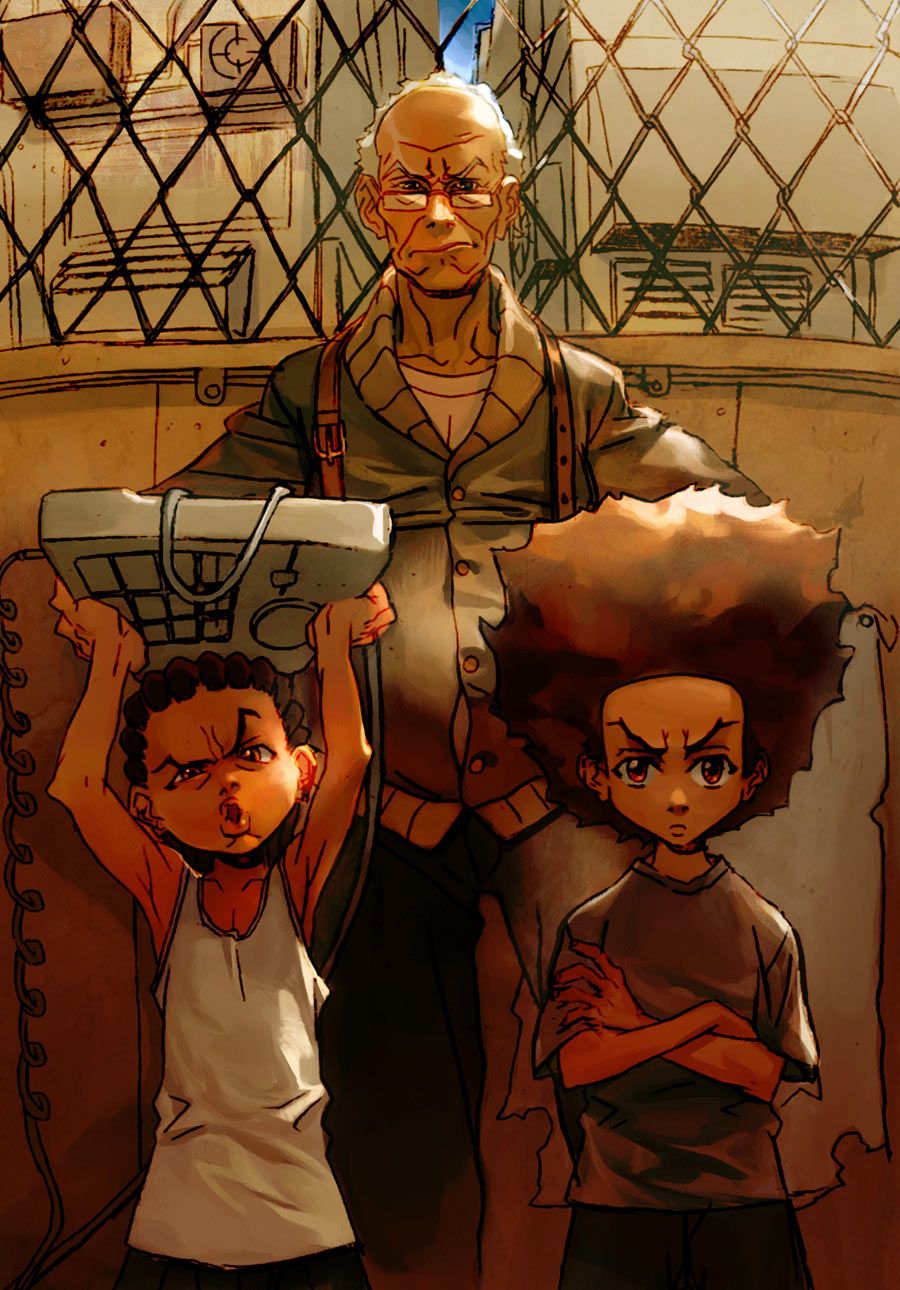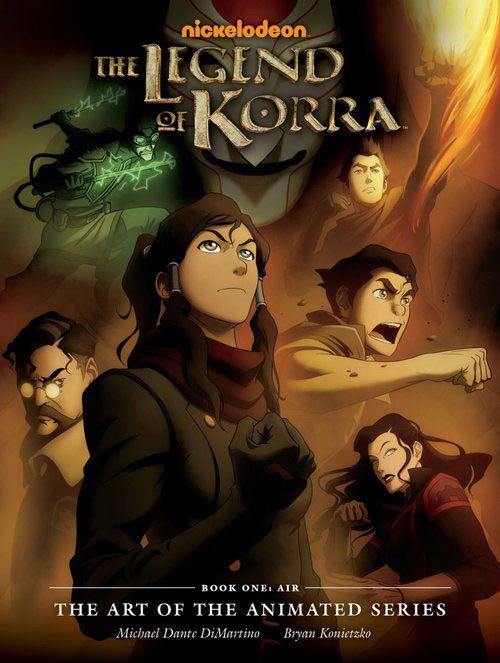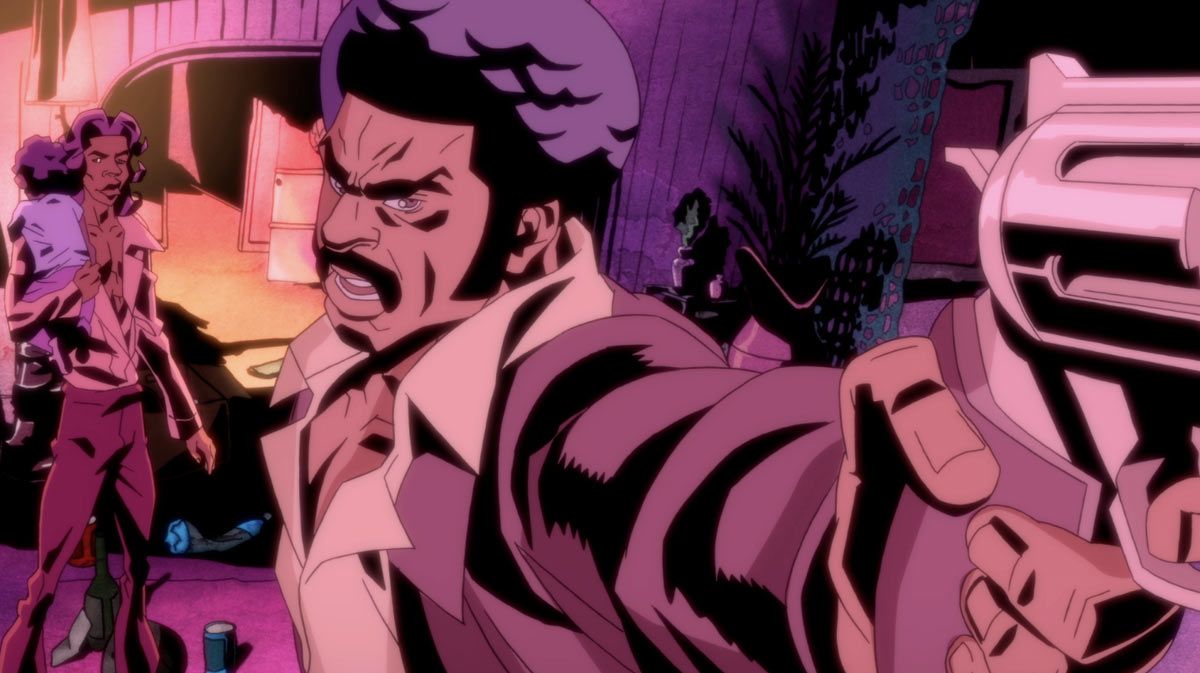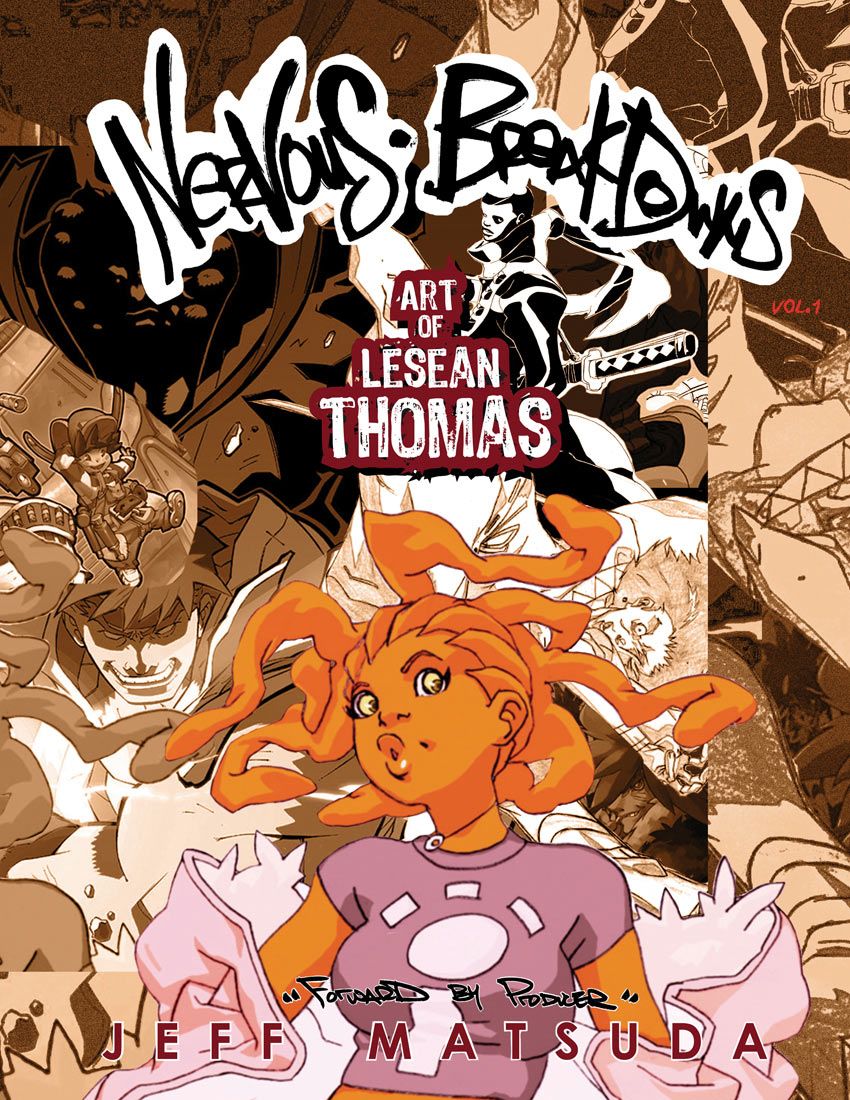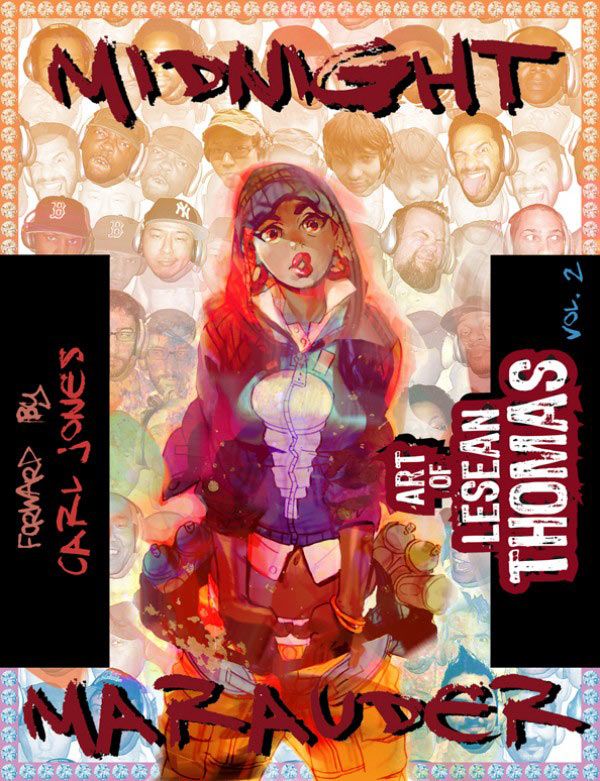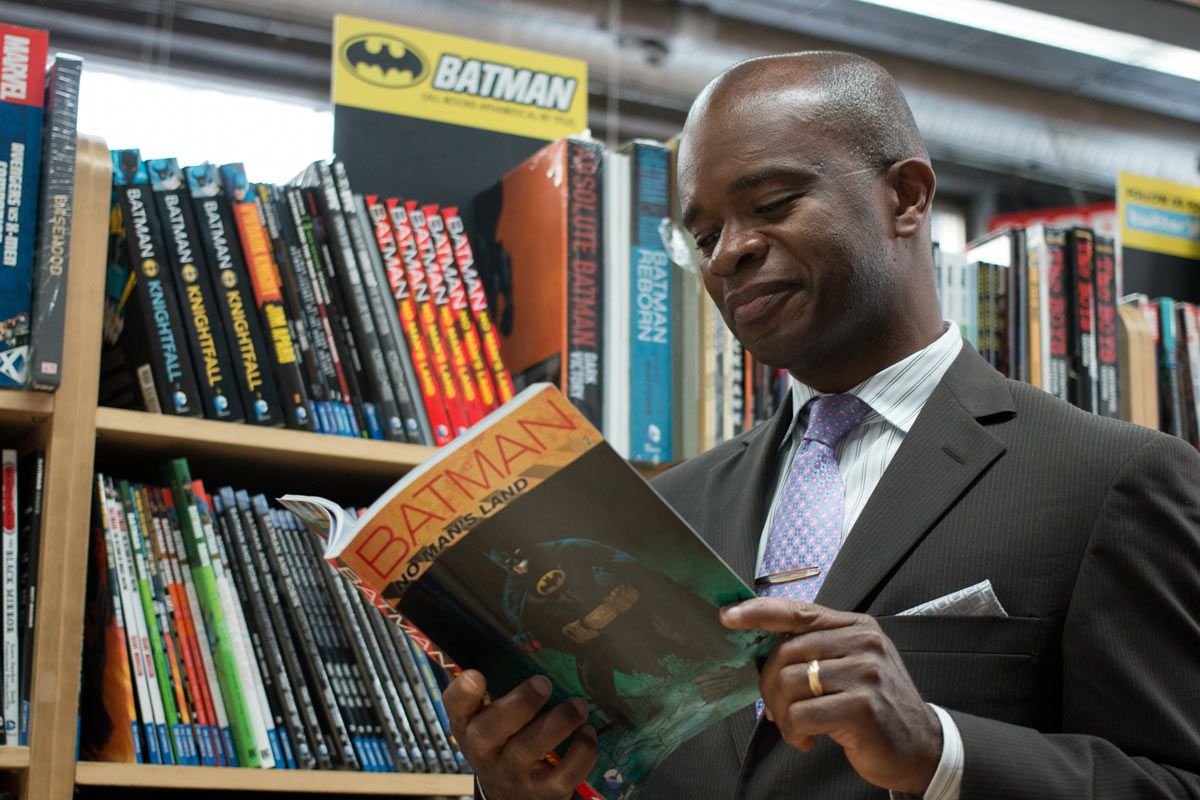THE MISSION is a weekly column spotlighting diversity in comic books, graphic novels, and popular entertainment.
The interviews and editorials featured will focus on successful entrepreneurs, whose accomplishments serve the goal of creating an equally diverse creative and business landscape.
LeSean Thomas is an American television animation producer and director in Los Angeles, California.
He serves as creative producer and supervising director of "Black Dynamite: The Animated Series," slated to enter its second season on Adult Swim later this year. His recent, notable projects include the "Legend of Korra" animated series for Nickelodeon, and Aaron McGruder's "The Boondocks" animated series (seasons one and two), which also aired on Adult Swim.
Joseph Phillip Illidge: You were born in the South Bronx, New York City. How did your hometown experiences shape your worldview and career?
LeSean Thomas: The older I get and the more I travel around America, the more I realize that growing up in NYC skews your perception of what's normal. Since I'm a mid-70s baby, I was born in the South Bronx, a year of a lot of "firsts" that would help change our world, apparently -- the same year we lost the Vietnam War, the invention of the personal computer, the first condom commercial aired, Francis Franco biting the bullet. A lot of wild things happened that year.
I grew up during the post-civil rights era, the birth of Reaganomics and the War on Drugs, the birth and home of Hip Hop culture... Needless to say, 1975 -1985 in general was a pretty polarizing decade. I think growing up in the projects, in a home of two brothers and two sisters, a single mom and grandmother taught me a lot about waiting and patience. At the same time, it taught me how to be savvy in getting my way and never taking "no" for an answer. The whole NYC Hustle thing in general was something that shaped how I wanted to make decisions in my life. I don't think about it much, but in hindsight, I think I got that from my hometown upbringing the most. I didn't spend much time outside of the South Bronx until I was 13. I didn't leave NYC until I was in my mid-20s and prior to that, I felt no need to leave. Why would I? New York City was the center of the earth to me at the time.
New York is so different now. A lot of my memories have been demolished and rebuilt with new tenants and establishments. But that's what developing cities do, and back then I learned quickly that the world is much bigger than New York City.
What was your first job in the animation industry, and when did you start to feel that you had a permanent place in the business?
My first official job in animation was as a storyboard/layout/character designer for a web cartoon called "WhirlGirl." I was assisting a colleague who would later become one of my mentors for a time, Joel Rodgers. Aesthetically, the show itself was more of what we would call today a motion comic in quality. We were using this new program at the time called Macromedia Flash. Adobe would purchase it a year or two later and become what many animators/graphic designers know as Adobe Flash. That was my first, legitimate job in the conventional sense when you think of animation production... at least when you consider the pre-production stage (designs, storyboards).
That web series enjoyed strong success, prompting it to be picked up by cable channel Showtime, and go on to be the first web series to be picked up by a major network. This was in 1998, at the turn of the century, the height of the Internet boom.
From there, the wild west of Internet era was in full swing; investors were dumping hundreds of millions into alleged web content providers with only 56k dial up available. No one had figured out how to create a legitimate revenue model to reap dividends that would be a return on these investors' financial bids. There were some solid ideas that came away from it before it all crashed in 2000. The following year, 9/11 would put the nails in the coffins. MTV animation began outsourcing to Canada and the like and operations all over town would shut down. It was a wild time in NYC.
To be honest, I never felt like I had a "permanent place" in the animation business, as you put it. I am still in the process of establishing myself in this business. If, by permanent, you mean when I felt "This is what I'm going to pursue, I'm in this fully." I would say after I finished my own web cartoon, "BattleSeed" for UBO, when I landed a gig as assistant animator on Disney's "Lizzie McGuire" show. That was the first time I'd been hired by an animation corporation to be a staffer. Prior to that, I'd had a lucky string of consistent freelance gigs. "Lizzie McGuire" made me feel like, "OK, I'm in the system now." Something that showed I could work in a conventional, studio environment.
How did your career lead to becoming the director and lead character designer for the award-winning animated series, "The Boondocks," created by Aaron McGruder?
Wow, let me see if I remember it right. It was such a long time ago. After I wrapped up my work on "Lizzie McGuire," I moved from Bed-Stuy, Brooklyn down south to Greensboro, North Carolina in 2002. This was where I decided to pursue a stint in independent comic books working for a short time with Dreamwave Comics. It was also where I met someone who would become a part of my creative career for the next decade and beyond; Carl Jones. Carl and I were introduced by my roommate Chris Walker, who at the time was the colorist on my first comic series -- "Arkanium," for Pat Lee's Dreamwave Comics imprint.
Carl and I hit it off immediately upon meeting and would later collaborate to start development on an animated TV series for Roc-A-Fella Records recording artist, Beanie Sigel. It was a hip-hop version of "Rugrats" in concept, starring his imprint of artists at the time, State Property, aptly titled "The Playpen."
Carl was the character designer and I was an Art Directing Consultant of sorts. We would go up to NYC and work in the Rocawear offices with Beans, the State Prop crew, their manager, etc. alongside co-writer Brian Ash (a buddy who worked with me at UBO), who contacted me about the project. Long story short, Beans got into a legal altercation that ceased development of the project. All we got out of it was a series bible really, but it was a great experience and the first of many projects Carl and I would collaborate on in the future.
Carl and his family eventually moved to LA, and that's where Carl ran into Aaron McGruder. They became connected and both would eventually work together on the last two years of the "Boondocks" comic strips.
Carl and I stayed in touch and before you know it, a Fox TV series pilot for "The Boondocks" was in the works. After the Fox pilot fell through, Adult Swim approached Aaron to produce it. Aaron was having trouble locating character designers in the TV animation circle in Hollywood who understood how to combine anime aesthetics, hip hop and black culture into one, palpable look that worked in long-form 2D animation. Carl showed him my work and was blown away. Aaron called me up and asked me to fly to LA to meet with him for a week and asked if I'd be down to help design the show. We started development in August of 2004. I eventually relocated to LA two months later and the rest as they would say, is history. We premiered in the fall of 2005, and the TV animation game was never the same after that.
After working on "The Boondocks," you moved to Seoul, South Korea -- a big leap, personally and professionally. Did you have a plan for a length of stay, or did you take the dive regardless of the depth of the pool, so to speak?
Yes, it was a big leap for me. And I had every intention of taking the dive regardless. But I ended up actually being terrified the first six months because of all the obstacles I hadn't anticipated. I was so infatuated with the idea of going and had been romanticizing about the creative aspect so much, I hadn't fully grasped the challenge of doing basic things such as using the right plastic bags for food, paper and plastics. Shopping for food, or clothes or basic toiletries, paying rent, cashing a check. I didn't speak the language. As an American, there were things that I took for granted that I expected them to know and as Koreans, there were things they took for granted that they expected me to know. It was then that I thought, "Maybe I should have thought this through more," ha ha. It was a struggle at first, to say the least.
After getting the approval from Joung Mee (J.M. Animation studio president) to work [at] J.M. Animation studios, it was decided I'd stay there on a one-year, E-7 Visa (Special Occupations Visa: designed for specific types of specialty work; as opposed to the standard, E-2 Visas in South Korea, which are for English Language teachers) and see what comes of it. I had no actual exit-strategy. The idea was for me to gain exclusive experience working in main production -- layout, key animation, clean-up, model check, ink and paint... the things that we don't do here in America on most of our animated TV shows. But there was a problem. A business decision within J.M. changed things in the summer of 2010; JM president and a founder/director of J.M. Animation Studio Yu Jaemyong parted ways as he formed his own company, which became Studio Mir ("Legend of Korra"). Unfortunately that business move created a rift in the operations at J.M. and, of course, put my time there in question. I was worried that I would have to come back prematurely. Since Joung Mee felt a sort of responsibility for me, and Yu Jaeyong had since taken me under his wing to learn how he did things, there was a discussion about what to do with me. I felt like the surrogate child for a moment. But they both agreed that it'd be best for me go with Jaemyong to his studio at Mir, extend my Visa and stay so that I could continue to get my experience. We went on to make "Legend of Korra (Book 1)." I'm forever grateful to them both for that.
In all honesty, the only reason I'd returned to America was because of "Black Dynamite." I was freelancing on the show from Korea at first while wrapping up my work on Book 1 of "Korra" and also working on some side projects, but when it was decided by Adult Swim that they needed me on the show as Creative Producer/Supervising Director, I decided it was worth ending my pilgrimage. It was a great opportunity to work on something fresh, new and original again with my boy Carl, one of the most creative collaborators I've had the good fortune of working with in my career. I came back in 2012 at Titmouse, only to eventually move back to South Korea for that summer to help ship the rest of season one out on time, ha ha.
We're now at Cartoon Network studios in Burbank, very busy on production of Season 2 of "Black Dynamite: The Animated Series," premiering this October.
In your TEDx Talk in South Korea, you revealed the problems adjusting to South Korea, and the rewards for sticking it out and staying. You were also very candid about your failures. Do you feel it's crucial for any creative person to own their failures, look them in the eye without fear, before she or he can reach new heights as a talent and professional?
Thanks for watching that. The TEDX event, "Successful Failures," was a seminar to promote facing fear of failure head-on. In Seoul, South Korea, roughly 80 percent of the youth between the ages of 18 to 35 -- the age where the most optimistic and ambitious thinking occurs in the business sphere -- objects to starting new business ventures in favor of joining the corporate structure of existing companies. The overt value of wealth and stability over creativity is staggering in Seoul, and "failure is still failure." The purpose of the event was to encourage youth to face failure head on and use it as a method of growth. Eleven speakers from various walks of life were chosen to speak at the event. I was chosen amongst them.
A little story behind that: It was actually my Seoul Sessions animation video diary series that got the TEDx Sinchon organizer's attention. The irony of it all is that when the project manager of the event contacted me via email, I initially refused to participate, because I thought I'd fail and do a crappy job. My girlfriend helped convince me otherwise. Even funnier is that I had written this long diatribe about failure and on the day of rehearsal (which was actually the day before the event) I was reading from my sheet and failed miserably! The project manager coached me and reminded me to take it easy and just be natural. "Come back tomorrow and nail it, don't worry," he said, but I was still terrified. The problem was that I was trying to recite the way I write and not the way I talked. It was too wordy, so I went home that same night, rewrote it as I would say it, and the following morning which was the day of the event, I got there and rehearsed. I wasn't going on stage until 5 p.m., so I practiced my lines until showtime. What you saw was the result.
As for the question of creative people facing their failures, of course. It's astounding how many people allow fear to ruin their chances for reaching a higher version of themselves. Even in a culture such as America, where more or less people value the arc a person reaches in their life in the face of adversity. It's in our novels, our stories, our films. We love rooting for the second chance. Nothing happens if you don't try.
You went from "The Boondocks," an insightful series about Black people and American society, to "The Legend of Korra," a fantasy adventure series cited for cultural diversity, to return to the States and become a producer and director for "Black Dynamite: The Animated Series," a brilliant comedy adventure in the Blaxploitation genre. As a person of color, do you feel uniquely qualified to explore stories showcasing diversity in the animation field?
No. I feel that I'm simply a singular voice projecting a specific point of view. I don't believe I am uniquely qualified to explore or speak on issues in such stories of diversity in the animation field, or represent the "Black Experience," as many like to call it. As I see it, the Black experience, so to speak, is nuanced, diverse and varied in and of itself. It'd behoove one to not assume I (or anyone) speak for every person of color (which isn't just African-Americans). Just ask animator Bruce Smith, or Peter Ramsey, or animator Tyree Dillihay, Floyd Norman or Ian Jones-Quartey what their idea of what qualifies as Black exploration in American animation is. I'm sure they will all have experiences and points of views that are different from mine. And they are all valid and relevant, because although you don't see a lot of us in animation on TV, CGI features and blockbuster Hollywood films, we are varied and extremely diverse.
I do, however, feel qualified to create more stories. Whether the content produced showcases diversity each and every time is dependent on the story told. "The Boondock" and "Black Dynamite" both depict white Americans in them, although they aren't the main characters, and that should be okay.
Your work has been published in various books, including "Nervous Breakdowns: The Art of LeSean Thomas Vol. 1" and "Midnight Marauder: The Art of LeSean Thomas Vol. 2." How are the two books different, and is there a Vol. 3 in the works?
Thanks for mentioning those! "Nervous Breakdowns: The Art of LeSean Thomas Vol. 1" was a self-published book thrown together in the wake of the "art book boom" amongst illustrators in the mid-'00s. It was close to 500 pages of sketches done from 1995-2005, paperback, black & white, and available at $40. It's still available.
The second art book, "Midnight Maruader; The Art of LeSean Thomas Vol. 2" was released a couple of years later. That one was about 150 pages, full color and hardbound. Unfortunately, I sold out and it's now only available on Amazon from $200 used, to upwards of $500 new.
A third book is actually in the works, "The Foreign Exchange: The Art of LeSean Thomas Vol. 3." It will be a two-book, paperback set inside a hardbound slipcase. Book 1 will be concept art, sketches, photos and essays. Book 2 will be a continuity booklet (storyboards) from various projects, known and unknown, with essays as well. I'm pushing for a fourth quarter release.
Like myself, you're an admirer of the works of ShinichirÅ Watanabe. "Cowboy Bebop" was a seminal contribution to the genre of Japanese anime, and I haven't met one fan of anime who doesn't love "Samurai Champloo." Which animators and producers inspire you these days?
Absolutely. Saying "I admire Watanabe" is like saying " I admire Jim Lee." Everybody does. [Laughs] He's one of the innovators of our generation! The short list of animators who inspire me today are Yutaka Nakamura ("Sword of the Stranger"), Masaaki Yuasa ("Kick Heart," "Mind Game"), In-Seung Choi ("Legend of Korra"), Hiroyuki Imaishi ("Kill La Kill"), Peter Chung ("Aeon Flux"), Takeshi Koike ("Redline"), Satoshi Kon (RIP), Jamaal Bradley (Dreamworks), Michio Mihara, Bahi JD ("Space Dandy"), Kihyun Ryu ("Legend of Korra"), Seung-Eun Kim ("The Boondocks"), Sayo Yamamoto (director, "Mitchiko to Hatchin"), Thomas Romain ("Space Dandy," "Oban Star Racers"). These are the folks who directly influence my output whenever I see their work or correspond with them personally, or both.
There are many others, but we'd be here all day.
Unlike many other people I've seen on Facebook, you use social media to teach the masses, sharing knowledge and lessons learned. Intentional, or did that just become the pattern for you over a period of time?
I think it became a pattern over time. I joined it like everyone else to stay connected, but then the friend requests just kept on coming. I saw it as an opportunity to unify my interests and make it more of a forum home, or a place to share my thoughts and learn more about other artists and people's POVs, likes and dislikes. The way people use Tumblr. It can get a bit heated at times, but that's healthy for critical thinking, I believe. It's fun.
Some people use Facebook for personal reasons, I prefer to use it as a tool to connect people together and interact. I also have an animation group I started on Facebook that I use for the same purpose. Getting people excited about art, animation and sharing knowledge and info. When it becomes a chore is probably when I'll back off from it all. But I do like sharing.
Looking at the upcoming "Big Hero 6" animated film by Disney, based on a Marvel comic book series, the "Black Dynamite" comic book series by IDW, and more DC Comics original animated features based on that publisher's library of comic book stories, there's a clear synergy between the art forms. Do you see yourself doing more printed stories in the future, to dovetail with your animated works?
I think so. I'd certainly like to. I started in animation first. I left animation to dip my toe in the indie comics scene (Dreamwave's "Arkanium" and "Teenage Mutant Ninja Turtles") until I was lured back into animation filmmaking for television. I wanted to focus on my career in animation as best I could. I felt for my personality and the type of stuff I like to involve myself in, animation as a storytelling medium was a much more liberating endeavor and for various reasons. I love the collaborative environment in which to produce and direct animated projects, the pay is better, the exposure and potential to reach a larger audience is stronger.
As for comics, I feel confident that if I do eventually do a comic series again, I won't be confined to the convention of trying to carve a name for myself on an existing X-Book or Bat-book, but it will be as someone known with existing credentials on popular shows. I also think I have a solid fan base outside of comics that I can bring to comics whenever I get back to it again. At least that's what I hope happens (knock on wood). [Laughs]
What are the cornerstones that account for your sustained career in the animation world? Work ethic? Imagination? Courage?
All. I'll also add "picking the right projects" to the fold. I've turned down about eight gigs in the last year. To some people, that's an insane thing to do in this economy. I'm not saying that I don't need the money, but I believe in quality, not quantity. It's a gamble, for sure, and it requires what you mentioned above -- courage -- to follow through. I'd rather wait a little than regret doing something I rushed that stays on my resume, or doing something I'm not proud of just for a quick buck. The money never lasts, but the embarrassing work you did or rushed out for it remains, and people remember you for that. But that's just me; I'm very careful about choosing the projects I attach myself to. Being able to successfully navigate that game is an art form as well. I'm still a work in progress of course... I reckon it's all a part of that New York hustle.
Joseph Phillip Illidge is the Head Writer for Verge Entertainment (www.verge.tv), a production company co-founded with Shawn Martinbrough, artist for the graphic novel series "Thief of Thieves" by "The Walking Dead" creator Robert Kirkman, and videogame developer Milo Stone. Verge has developed an extensive library of intellectual properties for transmedia development. Live-action and animated television and film, videogames, graphic novels, and web-based entertainment.
Joseph has been a public speaker on the subjects of race, comics, and politics at Digital Book World's forum, Digitize Your Career: Marketing and Editing 2.0, Skidmore College, Purdue University, on the panel "Diversity in Comics: Race, Ethnicity, Gender and Sexual Orientation in American Comic Books," and at the Soho Gallery for Digital Art in New York City.
His latest project is "The Ren," a 200-page graphic novel about the romance between a young musician from the South and a Harlem-born dancer in 1925, set against the backdrop of a crime war and spotlighting the relationship between art and the underworld. "The Ren" will be published by First Second Books, a division of Macmillan.
["The Mission" banner designed by Gavin Motnyk.]

